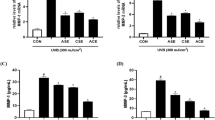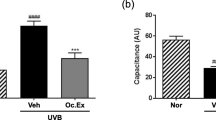Abstract
Cutaneous wound healing delay, collagen synthesis decline and wrinkle formation are the common features of skin aging. The aim of this study is to investigate repressive effects of Colla Corii Asini (CCA) (a traditional Chinese medicine which has been used for anti-aging) on hydrogen peroxide (300 µM, 2 h) and ultraviolet A (UVA) (3.2 mJ/cm2)-induced skin aging in vitro. To simulate the in vivo condition of CCA, CCA was digested by gastrointestinal enzymes and added to human gingival fibroblasts (HGF) and three dimensional (3D) skin equivalents at different concentrations. Cell viability assay showed that the enzyme-digested CCA (CCAD) exhibited significant preventive effects on hydrogen peroxide- and UVA-induced cell death. The in vitro scratch assay showed that CCAD was able to prevent hydrogen peroxide-induced wound healing delay in HGF cell sheets. Immunostaining and imaging analysis showed that CCAD could suppress UVA-reduced expression of type IV collagen and elastin in both HGF cells and the 3D skin equivalents. Using a tissue stretching system, wrinkles were formed on UVA-irradiated 3D skin equivalents. Without CCAD-treatment, the wrinkles on the skin were deep, whereas CCAD markedly reduced the depth of wrinkles. In conclusion, CCAD could protect skin cells from oxidative stress and UVA-induced harmful effects, accelerate wound healing, promote synthesis of collagen and elastin, and reduce wrinkles formation. CCAD might be developed as an anti-skin aging reagent in the cosmetic industry.






Similar content being viewed by others
Change history
19 October 2020
In the original version of the publication, the UVA dose and irradiation time were miscalculated.
References
Ray PD, Huang BW, Tsuji Y. Reactive oxygen species (ROS) homeostasis and redox regulation in cellular signaling. Cell Signal. 2012;24:981–90. https://doi.org/10.1016/j.cellsig.2012.01.008.
de Jager TL, Cockrell AE, Du Plessis SS. Ultraviolet light induced generation of reactive oxygen species. Adv Exp Med Biol. 2017;996:15–23. https://doi.org/10.1007/978-3-319-56017-5_2.
Valavanidis A, Vlachogianni T, Fiotakis K. Tobacco smoke: involvement of reactive oxygen species and stable free radicals in mechanisms of oxidative damage, carcinogenesis and synergistic effects with other respirable particles. Int J Environ Res Public Health. 2009;6:445–62. https://doi.org/10.3390/ijerph6020445.
Wu D, Zhai Q, Shi X. Alcohol-induced oxidative stress and cell responses. J Gastroenterol Hepatol. 2006;21(Suppl 3):S26–S2929. https://doi.org/10.1111/j.1440-1746.2006.04589.x.
Kim MJ, Woo SW, Kim MS, Park JE, Hwang JK. Anti-photoaging effect of aaptamine in UVB-irradiated human dermal fibroblasts and epidermal keratinocytes. J Asian Nat Prod Res. 2014;16:1139–47. https://doi.org/10.1080/10286020.2014.983092.
Brand RM, Epperly MW, Stottlemyer JM, et al. A topical mitochondria-targeted redox-cycling nitroxide mitigates oxidative stress-induced skin damage. J Invest Dermatol. 2017;137:576–86. https://doi.org/10.1016/j.jid.2016.09.033.
Khavkin J, Ellis DA. Aging skin: histology, physiology, and pathology. Facial Plast Surg Clin North Am. 2011;19:229–34. https://doi.org/10.1016/j.fsc.2011.04.003.
Zhang S, Duan E. Fighting against skin aging: the way from bench to bedside. Cell Transplant. 2018;27:729–38. https://doi.org/10.1177/0963689717725755.
Sgonc R, Gruber J. Age-related aspects of cutaneous wound healing: a mini-review. Gerontology. 2013;59:159–64. https://doi.org/10.1159/000342344.
Czekalla C, Schönborn KH, Döge N, et al. Impact of body site, age, and gender on the collagen/elastin index by noninvasive in vivo vertical two-photon microscopy. Skin Pharmacol Physiol. 2017;30:260–7. https://doi.org/10.1159/000477854.
Boisnic S, Branchet-Gumila MC, Le Charpentier Y, Segard C. Repair of UVA-induced elastic fiber and collagen damage by 0.05% retinaldehyde cream in an ex vivo human skin model. Dermatology. 1999;199(Suppl 1):43–8. https://doi.org/10.1159/000051378.
Karran P, Brem R. Protein oxidation, UVA and human DNA repair. DNA Repair (Amst). 2016;44:178–85. https://doi.org/10.1016/j.dnarep.2016.05.024.
Masaki H. Role of antioxidants in the skin: anti-aging effects. J Dermatol Sci. 2010;58:85–90. https://doi.org/10.1016/j.jdermsci.2010.03.003.
Xiao L, Liao F, Zhou X, Qin Y, Miwa N. Biological effects of traditional Chinese medicine Colla Corii Asini. New Food Indust. 2019;61:69–72.
Wang D, Ru W, Xu Y, et al. Chemical constituents and bioactivities of Colla Corii Asini. Drug Discov Ther. 2014;8:201–7. https://doi.org/10.5582/ddt.2014.01038.
Xiao L, Liao F, Ide R, et al. Enzyme-digested Colla Corii Asini (E’jiao) prevents hydrogen peroxide-induced cell death and accelerates amyloid beta clearance in neuronal-like PC12 cells. Neural Regen Res. 2020;15:2270–2. https://doi.org/10.4103/1673-5374.285000.
Xiao L, Miwa N. Hydrogen-rich water achieves cytoprotection from oxidative stress injury in human gingival fibroblasts in culture or 3D-tissue equivalents, and wound-healing promotion, together with ROS-scavenging and relief from glutathione diminishment. Hum Cell. 2017;30:72–877. https://doi.org/10.1007/s13577-016-0150-x.
Boukamp P, Petrussevska RT, Breitkreutz D, Hornung J, Markham A, Fusenig NE. Normal keratinization in a spontaneously immortalized aneuploid human keratinocyte cell line. J Cell Biol. 1988;106:761–71.
Ogura Y, Muta K, Matsunaga Y, Hirao T, Amano S. In vitro reconstruction of 3-D elastic fiber in a novel dermal equivalent. J Soc Cosmet Chem Jpn. 2010;44:278–84.
Xiao L, Okamura H, Kumazawa Y. Three-dimensional inflammatory human tissue equivalents of Gingiva. J Vis Exp. 2018. https://doi.org/10.3791/57157.
Xiao L, Ide R, Saiki C, Kumazawa Y, Okamura H. Human dental pulp cells differentiate toward neuronal cells and promote neuroregeneration in adult organotypic hippocampal slices in vitro. Int J Mol Sci. 2017;18:1745. https://doi.org/10.3390/ijms18081745.
Xiao L, Sakagami H, Miwa N. A new method for testing filtration efficiency of mask materials under sneeze-like pressure. Vivo. 2020;34:1637–44. https://doi.org/10.21873/invivo.11955.
Schäfer M, Werner S. Oxidative stress in normal and impaired wound repair. Pharmacol Res. 2008;58:165–71. https://doi.org/10.1016/j.phrs.2008.06.004.
Sorrell JM, Caplan AI. Fibroblast heterogeneity: more than skin deep. J Cell Sci. 2004;117:667–75. https://doi.org/10.1242/jcs.01005.
Lam S, van der Geest RN, Verhagen NA, Daha MR, van Kooten C. Secretion of collagen type IV by human renal fibroblasts is increased by high glucose via a TGF-beta-independent pathway. Nephrol Dial Transplant. 2004;19:1694–701. https://doi.org/10.1093/ndt/gfh235.
Kajiya H, Tanaka N, Inazumi T, Seyama Y, Tajima S, Ishibashi A. Cultured human keratinocytes express tropoelastin. J Invest Dermatol. 1997;109:641–4. https://doi.org/10.1111/1523-1747.ep12337639.
Wrenn DS, Griffin GL, Senior RM, Mecham RP. Characterization of biologically active domains on elastin: identification of a monoclonal antibody to a cell recognition site. Biochemistry. 1986;25:5172–6. https://doi.org/10.1021/bi00366a028.
Ferdowsian HR, Gluck JP. The ethical challenges of animal research. Camb Q Healthc Ethics. 2015;24:391–406. https://doi.org/10.1017/S0963180115000067.
Xiao L, Miwa N. The lipophilic Vitamin C derivative, 6-O-palmitoylascorbate protects human keratinocytes and 3D-human skin equivalents against X-ray-induced oxidative stress and apoptosis more markedly than L-ascorbic acid. J Cell Biochem. 2017;118:318–29. https://doi.org/10.1002/jcb.25639.
Pöschl E, Schlötzer-Schrehardt U, Brachvogel B, Saito K, Ninomiya Y, Mayer U. Collagen IV is essential for basement membrane stability but dispensable for initiation of its assembly during early development. Development. 2004;131:1619–28. https://doi.org/10.1242/dev.01037.
Vázquez F, Palacios S, Alemañ N, Guerrero F. Changes of the basement membrane and type IV collagen in human skin during aging. Maturitas. 1996;25:209–15. https://doi.org/10.1016/s0378-5122(96)01066-3.
Sephel GC, Davidson JM. Elastin production in human skin fibroblast cultures and its decline with age. J Invest Dermatol. 1986;86:279–85. https://doi.org/10.1111/1523-1747.ep12285424.
Wang D, Liu M, Cao J, et al. Effect of Colla Corii Asini (E'jiao) on D-galactose induced aging mice. Biol Pharm Bull. 2012;35:2128–32. https://doi.org/10.1248/bpb.b12-00238.
Xu X, Guo S, Hao X, Ma H, Bai Y, Huang Y. Improving antioxidant and antiproliferative activities of Colla Corii Asini hydrolysates using ginkgo biloba extracts. Food Sci Nutr. 2018;6:765–72. https://doi.org/10.1002/fsn3.587.
Knupp C, Squire JM. Molecular packing in network-forming collagens. Adv Protein Chem. 2005;70:375–403. https://doi.org/10.1016/S0065-3233(05)70011-5.
Acknowledgements
The present study was supported in part by a Grant-in-Aid for AntiAging Scientific Research #1517 by Japanese Center for AntiAging MedSciences, Hiroshima, Japan to LX and TaiShan Industrial Experts Program of China No. TSCY20170233 (to FL). The authors also appreciate Nathaniel Green’s proofreading.
Author information
Authors and Affiliations
Contributions
All authors contributed to the study conception and design. Material preparation, data collection and analysis were performed by LX and FL. Some experiments were performed by YF. The first draft of the manuscript was written by LX. Nobuhiko Miwa revised the manuscript and commented on previous versions of the manuscript. All authors read and approved the final manuscript.
Authors Feng Liao and Yumei Fan are employees of Dong-E-E-Jiao Co. Ltd.
Corresponding author
Ethics declarations
Conflict of interest
Li Xiao and Nobuhiko Miwa have reported no potential conflict of interest relevant to this article.
Additional information
Publisher's Note
Springer Nature remains neutral with regard to jurisdictional claims in published maps and institutional affiliations.
Rights and permissions
About this article
Cite this article
Xiao, L., Liao, F., Fan, Y. et al. Enzyme-digested Colla Corii Asini (E’jiao) accelerates wound healing and prevents ultraviolet A-induced collagen synthesis decline and wrinkle formation in three-dimensional skin equivalents. Human Cell 33, 1056–1067 (2020). https://doi.org/10.1007/s13577-020-00405-y
Received:
Accepted:
Published:
Issue Date:
DOI: https://doi.org/10.1007/s13577-020-00405-y




